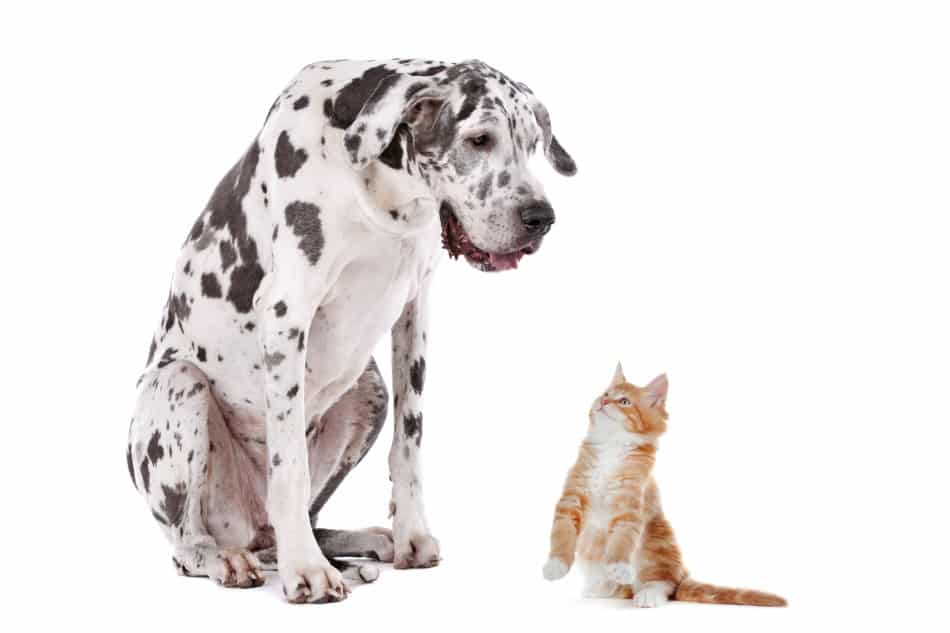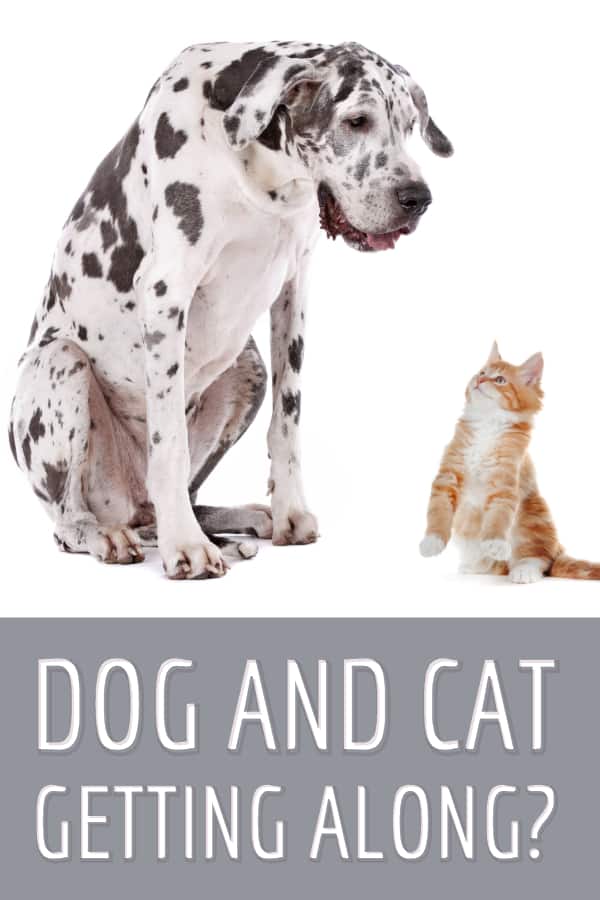
Great Danes might be giant dogs, but that doesn’t mean they can’t get along with cats! To ensure a positive interaction between your pets, there are a few important steps to follow.
The most important step is to properly introduce the Great Dane and cat. While most Great Danes are gentle with cats and other small pets, some may be overly curious or even aggressive. When introduced properly, this is much less likely to happen and will encourage a positive relationship between the animals.
Most Great Danes are very gentle and kind, and when introduced properly, there is a large possibility they will get along with cats and other pets.
Properly Introducing your Great Dane and Cat
Even if the Great Dane likes the cat, their large size may frighten the cat when they attempt to play. This is especially true if the dog is still a puppy and may not yet have fully developed social skills.
It’s important to give the cat space to “escape” if she is not in the mood to play or frightened by the dog’s large size.
As cats need time and patience to get adjusted to a new family member, make sure they have plenty of spots in the house that they can use to hide and retreat. If your cat is the indoors-only type, keep a close eye on them as they may try to escape outside to avoid the stress of being around the new dog.
Your Dane might be kind and loving to your cat, but that doesn’t mean every cat will love back, at least not right away. Depending on the cat’s personality, it might take longer to accept the new family member.
Ways to ensure safe spots and avoid conflict
Even with their giant size, Great Danes can’t reach the highest spots in your home. Giving your cat a high space to retreat to when they feel stressed out is a good idea. You can also install a pet/baby gate between rooms, to avoid conflict (especially in the first phases of getting to know each other).
Even if your Dane is peaceful, the cat may feel threatened scratch the dog. To ensure a pleasant experience for everyone is better to provide safe spots and protection until they get completely adjusted.
As your dog and cat might get along in a shorter time, some of them will take longer and require more patience. Especially in the first months, it’s very important not to leave them alone together!
While your Great Dane may not be aggressive, most are not aware of its size and strength, and can accidentally play to rough or even potentially injure the cat while playing.
Training your Great Dane to get adjusted to the cat
As your Great Dane is most likely gentle and loving, his size and strength have to be considered. Adjusting your Dane to the cat, letting him know that the cat is not prey or a toy, is a process and should be taken seriously.
A good idea is to walk your dog before planned encounters to ensure that he is calm. Once your dog is calm and a little tired, you can bring the cat inside the room. Hold the cat in the air, not allowing any direct contact.
It’s also very important that you stay calm, as both animals are likely to sense any nerves that you may be feeling. Stay in the same room, holding the cat, helping both of them to remain calm with gentle moves and words. If your cat gets uncomfortable, you should take her away, so she can calm down.
As they get more comfortable with each other, you can even place them together (on the floor, or sofa), staying in the room to monitor what they do.
It’s very important to never leave them alone in these stages as the Great Dane might get excited. Alternatively, the cat may feel overwhelmed and lash out at even the calmest of dogs.
Some common signs that your cat is not comfortable with the encounter include:
- hissing or growling
- raised hair
- dilated pupils
- ears laid flat
- arched back or body flattened to the ground (looking like they’re about to pounce)
Puppy or adult?
It might be easier to pair your pets if they are raised together from an early age (puppy and kitten). However, in most cases that is not possible, as many people decide to adopt adult pets from the shelter.
Danes that were socialized to live with other dogs and animals should get fairly easily adjusted. The problem might occur if the dog has certain traits of aggression and has never been properly socialized with people and other animals.
It’s important to find a dog with a friendly personality and proper socialization to assure there will be no aggression towards other pets or people.
Great Dane Socialization
Young Danes will need more interaction with the world than some other breeds to have a steady temperament and gain confidence. If not properly disciplined, they can be pushy and even aggressive.
Obedience training is very important but should be done carefully and without aggression.
When properly socialized, most Great Danes will be peaceful around other pets. In any case, proper introduction, socialization, and supervision are very important.
Are Great Danes good with other pets?
Many rules that apply to Great Dane/cat socialization also apply to other pets. They need to be properly introduced to each other, which can take time and patience.
Make sure you follow your common sense and always pre-plan. Staying calm and composed is also very important. Just like with Danes and cats, supervision for other pets is a must, and they should never be left alone in the first months of socialization.
Later on, if left alone, smaller pets also need to have safe spots around the house to retreat if necessary.
Showing your dog that the other pets are not toys or prey, is an important process. If all these steps are followed, there is a high likelihood that your gentle giant (Great Dane), will live in peace with any pet that you bring home.
Better to be safe than sorry
Even if your Great Dane and cat look like they are completely adjusted, caution is always needed. The same goes for other pets. Why do you ask? Your dog always has its prey drive, and stressful and unknown situations might bring the aggression out.
Also, the dog’s size needs to be considered, as accidents might happen, even if the dog is playing. If you are not home, it’s very important to separate them and give the cat (or other smaller pet), safe spots in the house that they can retreat to.
As mentioned before, cat trees, high areas, baby/pet gates, or separate rooms are a must.
Understand that your dog might be very loving, and might get along with the cat and other pets, but stressful events, aging, diseases, and other factors might evoke unexpected behaviors. So it’s better to be safe than sorry!
Other Dog Breeds That Are Good With Cats
Golden Retriever
Golden retrievers are good with children and tolerant to most pets. They usually do well with kittens or adult cats.
Even when playing with the cat, they will be gentle most of the time and there is a small chance they will hurt the cat. Like in any other case, supervision and socialization is a must.
In some cases, they might even decide to nurse or raise small kittens.
Maltese
Maltese can be couch potatoes and often don’t pay too much attention to their surroundings (including cats).
They are good with kittens and older cats, as they can be friendly but also not too pushy, and will leave the cat alone if she needs peace. Like with other breeds, proper introduction and supervision are necessary.
Beagle
Beagles are used to hunting in packs and are often friendly with other pets. More likely they will see the cat just as another pack member. They will play and snuggle with the cat.
Beagles need a lot of activity, so make sure they get it (for their health and not to bug other members of the family). Supervision, like with other breeds, is a must, especially in the first months.
Pug
Pugs, the cute little gremlins like to sleep and cuddle, and the cat can be a perfect companion. Pugs do well with children and cats due to their friendly nature. They like attention, so it’s good if a cat is their playmate and snuggle companion, while you are at work or school.
English and French Bulldog
Bulldogs are always lazy and hungry, and they just love to nap. What better napping companion than a cat?
However, they are different sizes and shapes of bulldogs, and especially with bigger ones, caution is needed.
Even as small as a French Bulldog, your dog and cat will need proper introduction and supervision.
Spaniels
Spaniels are very loving and patient and will love your cat even if they get a few scratches.
They are very loving and affectionate with their owners and also cats. Its tender and patient temperament make it one of the best matches for your cat.
Papillon
Papillion is a smaller breed, with its ears shaped like butterflies. Loving with people and other pets, they will make a good companion for your cat.
Their curiosity and playful attitude will ensure they will get along with cats.
Bichon Frise
Small, fluffy and playful, Bichon will more likely accept your cat as his buddy and playmate.
Its size and playfulness make it safer to play with your cat, without hurting her.

